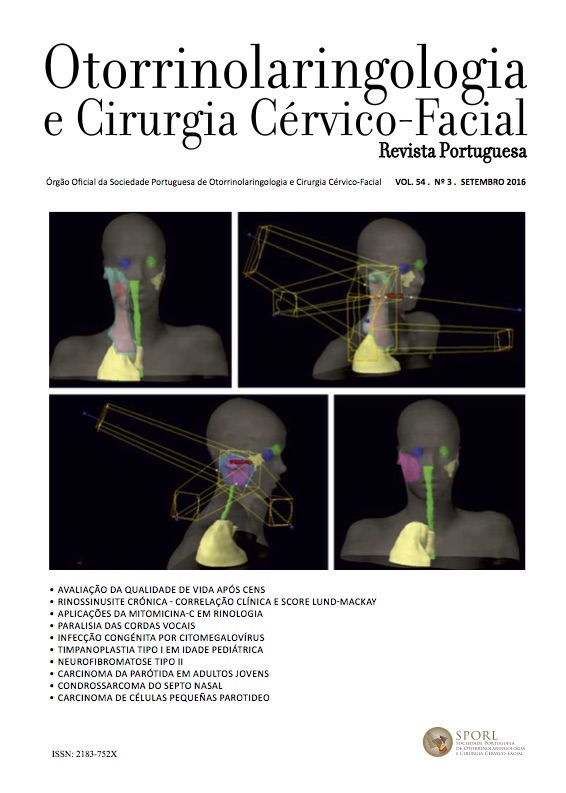Congenital cytomegalovirus infection: A leading cause of sensorineural hearing loss
DOI:
https://doi.org/10.34631/sporl.373Keywords:
cytomegalovirus, congenital infection, sensorineural hearing lossAbstract
Introduction: Cytomegalovirus is the most common cause of congenital viral infection, being also a leading nonhereditary cause of sensorineural hearing loss.
Material and methods: From 2010 to 2014, patients with congenital cytomegalovirus infection were retrospectively analysed, in a single hospital centre.
Results: During the study period, 15 396 births were identified in our centre with 15 children (0,1%) meeting the inclusion criterion for the diagnosis of congenital CMV infection. From the baseline characteristics of the population we observed 53% male new borns (NB), with a mean gestational period of 34±5.1 weeks, 20% of premature births and 26% of NB with a very-low birth weight (≤1500g). A primary CMV infection was found in 75% of patients and 26% were co-infected with HIV type 1 virus. In this cohort, 26.7% of NB presented with a certain degree of hearing loss, with 13% of NB developing late hearing loss.
Conclusions: Congenital CMV infection can only be reliably diagnosed in the first three weeks of life. Furthermore, the deficiency of new-born CMV screening programs, and lack of standard definition for symptomatic infection during pregnancy and the neonatal period, the rigorous prevalence of congenital CMV infection and burden of CMV related SNHL are challenging to estimate.
Downloads
References
Benoist G, Jacquemard F, Leruez-Ville M, Ville Y. Infection congénitale à Cytomégalovirus (CMV). Gynécologie Obstétrique Fertil. 2008 Mar;36(3):248–60.
Fowler KB, Stagno S, Pass RF, Britt WJ, Boll TJ, Alford CA. The outcome of congenital cytomegalovirus infection in relation to maternal antibody status. N Engl J Med. 1992 Mar 5;326(10):663–7.
Saigal S, Lunyk O, Larke R, Chernesky MA. The outcome in children with congenital cytomegalovirus infection: A longitudinal follow-up study. Am J Dis Child. 1982 Oct 1;136(10):896–901.
Goderis J, Leenheer ED, Smets K, Hoecke HV, Keymeulen A, Dhooge I. Hearing Loss and Congenital CMV Infection: A Systematic Review. Pediatrics. 2014 Oct 27;peds.2014–1173.
Grosse SD, Ross DS, Dollard SC. Congenital cytomegalovirus (CMV) infection as a cause of permanent bilateral hearing loss: A quantitative assessment. J Clin Virol. 2008 Feb;41(2):57–62.
Ludwig A, Hengel H. Epidemiological impact and disease burden of congenital cytomegalovirus infection in Europe. Euro Surveill Bull Eur Sur Mal Transm Eur Commun Dis Bull. 2009 Mar 5;14(9):26–32.
Wang C, Zhang X, Bialek S, Cannon MJ. Attribution of Congenital Cytomegalovirus Infection to Primary Versus Non-Primary Maternal Infection. Clin Infect Dis. 2011 Jan 15;52(2):e11–3.
Picone O, Vauloup-Fellous C, Cordier AG, Guitton S, Senat MV, Fuchs F, et al. A series of 238 cytomegalovirus primary infections during pregnancy: description and outcome. Prenat Diagn. 2013 Aug 1;33(8):751–8.
Morton CC, Nance WE. Newborn Hearing Screening — A Silent Revolution. N Engl J Med. 2006 May 18;354(20):2151–64.
Boppana SB, Ross SA, Fowler KB. Congenital cytomegalovirus infection: clinical outcome. Clin Infect Dis Off Publ Infect Dis Soc Am. 2013 Dec;57 Suppl 4:S178–81.
Foulon I, Naessens A, Faron G, Foulon W, Jansen AC, Gordts F. Hearing thresholds in children with a congenital CMV infection: a prospective study. Int J Pediatr Otorhinolaryngol. 2012 May;76(5):712–7.
Gabrielli L, Bonasoni MP, Santini D, Piccirilli G, Chiereghin A, Guerra B, et al. Human fetal inner ear involvement in congenital cytomegalovirus infection. Acta Neuropathol Commun. 2013 Oct 2;1:63.
Coutinho M, Monteiro L. Grisi - Grupo de Rastreio e Intervenção da Surdez Infantil. Grisi - An association for hearing screening [Internet]. 2006 Sep [cited 2015 Apr 20]; Available from: http://repositorio.chporto.pt/handle/10400.16/1183
American Academy of Pediatrics, Joint Committee on Infant Hearing. Year 2007 position statement: Principles and guidelines for early hearing detection and intervention programs. Pediatrics. 2007 Oct;120(4):898–921.
Karltorp E, Hellström S, Lewensohn-Fuchs I, Carlsson-Hansén E, Carlsson P-I, Engman M-L. Congenital cytomegalovirus infection – a common cause of hearing loss of unknown aetiology. Acta Paediatr. 2012 Aug 1;101(8):e357–62.
Fowler KB. Congenital cytomegalovirus infection: audiologic outcome. Clin Infect Dis Off Publ Infect Dis Soc Am. 2013 Dec;57 Suppl 4:S182–4.






